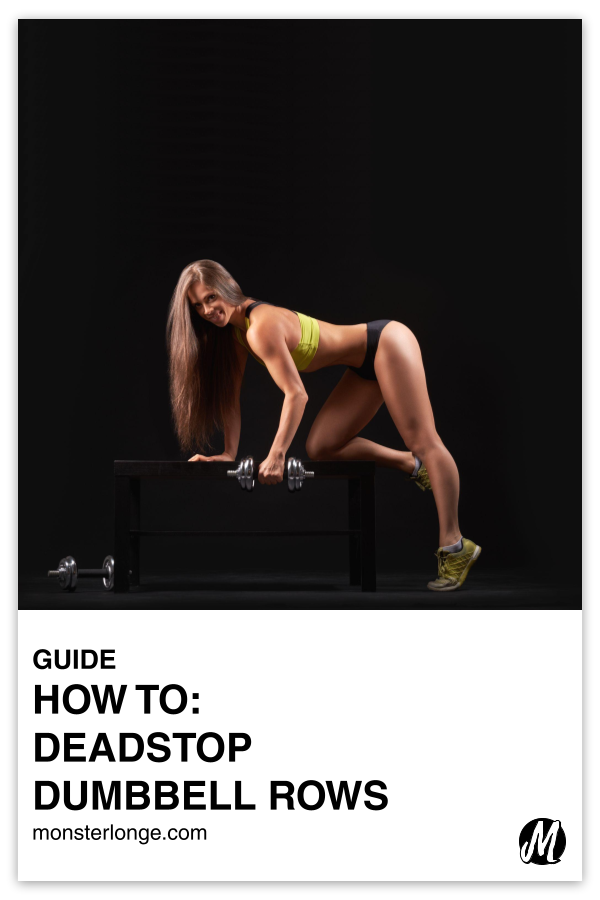
How To: Deadstop Dumbbell Rows
I take it that you want a thick back, right?
How’d I know?!?!
Well, it’s nice of you to think that I’m a world-class sleuth but the inclusion of one-armed dumbbell rows in your routine is sort of what gave it away.
While that exercise is indeed one of the best movements for the development of the upper back and lats, you may not be getting as much out of the exercise as you should for one very popular reason among most people who perform it. That common issue is the use of momentum to move the weight rather than the intended muscles. Deadstop dumbbell rows are the solution to this problem that you didn’t know you had but will pick up on when you perform them and not only find the movement more challenging but also feel your back and lats working in ways that you’ve never felt before when doing one-armed dumbbell rows the way you were doing them.
INSTRUCTIONS
1). Place a dumbbell on the ground next to a flat bench along the side you intend to row.
2). Stand in front of the bench.
3). If you intend to row with your right arm, rest your left knee on top of the bench and hinge at the hips and bend over until your torso is parallel to the floor, then place your left hand flat on the bench to support your body weight.1The hand of the support arm should be directly under your shoulder and the arm should have a slight bend at the elbow. The support leg should be directly beneath your hips with a slight bend at the knee and your foot flat on the ground. If that’s not comfortable, the support leg may also be extended behind you. When doing so, there should still be a slight bend at the knee but your heel may be elevated while the ball of your foot is the only part that remains on the ground.2The exercise may also be performed without a bench. To do so, stand in front of a raised surface that’s the same height as your knee or hip. Next, place both of your feet flat on the ground and about shoulder-width apart then bend over and rest your non-rowing hand on the elevated surface in front of you.
4). Reach down and grab the dumbbell with your right arm.
5). While keeping a soft bend in your right arm, brace your core and breathe out as you retract your shoulder blade and drive your arm toward your body until your elbow is in line with your trunk.3Your hand only serves a hook to hold the dumbbell. Concentrate on using your elbow, NOT your arm, to generate the force to move the weight. To further take your arm out of the movement, use a suicide (i.e. thumbless) grip around the dumbbell. Also, keep your arm tucked close to your body and avoid rotating your torso as you lift.
6). Pause and squeeze your lats for 1-2 seconds.4Pretend like you have oranges in your armpits and you’re trying to squeeze them to make delicious armpit orange juice.
7). Breathe in and slowly lower the dumbbell to the starting position.
8). Rest the dumbbell on the ground and let go of it completely.
9). Pause for 1-2 seconds then pick it up again and proceed to the next rep.
NOTE: Many people row with a straight up and down motion.5In other words, they pull in a straight line from directly below their chest up to their rib cage. While there’s nothing “wrong” with that, it’s not exactly the best way to target the lats if performing rows for that purpose. The fiber orientation of the lats more closely resembles that of when the arm travels in a forward and backward, or sweeping, pattern. So that’s the path that the dumbbell should take when the intention is development of the lats. As such, set the exercise up so you start with your hand on the dumbbell about an inch or two in front of your head so you can row the dumbbell to your hip in more of an arcing motion, which you can do by thinking of making the letter “J” with your arm as you row the dumbbell from the floor toward your hip.
For a workout routine that possibly includes deadstop dumbbell rows, as well as other exercises geared specifically to your goals, training experience, injury history, and available equipment, then find out more HERE
Glossary: arms, bench, chest, dumbbell, exercise, goal, lats, muscle, routine
